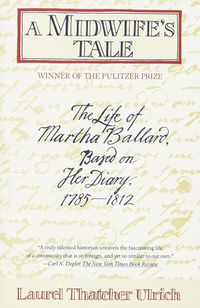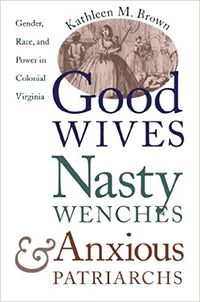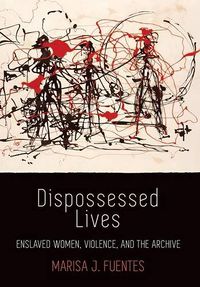Gender in Early America Top Ten Booklist
Most of us are familiar with a narrative of colonial America that focuses on the actions of our "Founding Fathers." But what of our "Founding Mothers"? This booklist compiles ten works that explore gender in colonial North America and provide an important lens through which we can view some of the formative events in our shared history. These books are listed in no particular order and explore topics from the daily and otherwise mundane like in Ulrich's A Midwive's Tale, to race and slavery in Brown's Good Wives, Nasty Wenches, & Anxious Patriarchs, and Morgan's Laboring Women. These books explore concepts of citizenship as well as biological reproduction and power.
1. Laurel Thatcher Ulrich, A Midwive's Tale: The Life of Martha Ballard, Based on Her Diary, 1785-1812, (Vintage Books, 1990).
This book is a classic. In it, Laurel Thatcher Ulrich contextualizes the "exhaustive, repetitious dailiness" of Martha Ballard's life. Ballard kept a diary for more than 27 years, and Ulrich was able to create a clear picture of what life was like for in New England. Through her analysis of Ballard's diary, Ulrich covers topics from abortion and childbirth to rape. Ulrich's work is a rich resource for those interested in what average life looked like in the late 18th century.
2. Carol F. Karlsen, The Devil in the Shape of a Woman: Witchcraft in Colonial New England, (W.W. Norton & Co., 1998).
The history of witchcraft in colonial America is both eerie and fascinating. Part of our fascination stems from how intellectually frustrating this phenomenon--the Salem Witch Trials, for example--was, but also how dramatic colonists' responses to these witches were. Karlsen explores the history of witchcraft in colonial America with clarity. Expressing that the history of witchcraft is women's history, and our analysis of can shift when we explore for an explicitly gendered lens.
3. María Elena Martínez, Genealogical Fictions: Limpieza de Sangre, Religion, and Gender in Colonial Mexico, (Stanford University Press, 2008).
In Genealogical Fictions, Martínez charts the rise of racial categories in Spain's colonies. Martínez details the origin of this system in the Iberian peninsula, then charts the transformations and problems that emerge when this system is imposed onto a diverse and distant population. One of the central pillars of this book is the focus on gender and sexuality. As a system concerned with biological reproduction, female sexuality was central to determining legitimacy, hierarchy, and purity. But Martínez goes even further to detail how gendered descriptions were fixed to colonized peoples--ultimately cementing their fixed positions in the Spanish racial hierarchy.
4. Kathleen M. Brown, Good Wives, Nasty Wenches, & Anxious Patriarchs: Gender, Race, and Power in Colonial Virginia, (University of North Carolina Press, 1996).
This book is, in many ways, a challenge to Edmund Morgan's American Slavery, American Freedom. In it, Brown argues that gender became a category of difference before race really entered American colonists' vocabulary. Beginning, of all things, with colonial tax law, Brown argues that the way that Virginia colonists perceived African and black women differently from English women helped to create a system of racial difference that ultimately led to racial slavery. A must read.
5. Sharon Block, Rape and Sexual Power in Early America, (University of North Carolina Press, 2012).
In Rape and Sexual Power in Early America, Sharon Block provides a comprehensive analysis of rape accusations and prosecutions from approximately 1700-1820. Block examined more than 900 documented incidents of "sexual coercion" to illustrate the dynamics of sexual power in play in British North America. According to Block, definitions of rape or assault were more frequently based on the identities of the parties involved. Through her analysis of these documents, Block argues that the way official persecuted these infractions worked to preserve the social, racial, gender, and political hierarchies of early North America.

6. Clare A. Lyons, Sex Among the Rabble: An Intimate History of Gender and Power in the Age of Revolution, Philadelphia, 1730-1830, (University of North Carolina Press, 2006). In this fascinating book, Lyons centers her analysis on the sexual practices of "the rabble," and explores the limits of freedom and individualism. Like Block, Lyons argues that sex and gender were crucial to reconstituting social hierarchies.
7. Jennifer L. Morgan, Laboring Women: Reproduction and Gender in New World Slavery, (University of Pennsylvania Press, 2004).
In this book, Jennifer Morgan focuses her attention on slave women and their bodies from the 1640s to the 1750s, approximately. Specifically, Morgan is concerned with slave women's statuses as producers (i.e. laborers), and reproducers (biological). She explores several different slave systems in the Atlantic world to piece together an interesting analysis of how slave traders and slave owners viewed slave women, and how slave women negotiated their own existence as well.
8. Carol Berkin, Revolutionary Mothers: Women in the Struggle for America's Independence, (Vintage, 2006).
For those craving a female counterpart to the traditional narrative of the American Revolution, this book is for you. Carol Berkin retells the now-common story of the American Revolution through the eyes of women who lived through and participated in it--from generals' wives to everyday women participating in boycotts of British Goods. Berkin allows us to get a complete picture of this significant event in American history.
9. Bárbara O. Reyes, Private Women, Public Lives: Gender and the Missions of the California, (University of Texas Press, 2009).
In this book, Bárbara Reyes explores what life was like for women in Spanish California. Reyes looks, first, at the creation of the missions in California then moves to analyze three three different women and their experiences from the late 18th century to the early 19th century: an Indian woman accused of murdering a priest, a Spanish woman who accuses her husband of adultery, and a Mestiza woman who became the lavera or head housekeeper at the San Gabriel Mission.
10. Marisa J. Fuentes, Dispossessed Lives: Enslaved Women, Violence, and the Archive, (University of Pennsylvania Press, 2016). In this book, Marisa Fuentes takes us to Bridgetown, Barbados where she takes us through the lives of women--enslaved an free--who would otherwise be invisible in the historical record. Using interdisciplinary methods, pieces together a narrative from fragmentary sources and also looks at the archives themselves and how they mark women's bodies.
Related DailyHistory.org Articles
- Thomas Jefferson, the Founding Fathers and Christianity: Interview with Sam Haselby
- American Revolution Top Ten Booklist
- The Alien and Sedition Acts of 1798: Interview with Terri Halperin
- Hodges' Scout: Interview with Len Travers
- Why did African Americans join the British Army during the American Revolution?


